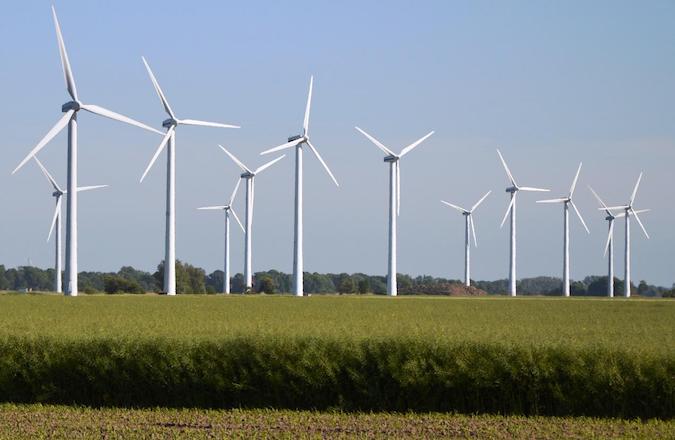Earlier this month, the UK Government announced a change to the National Planning Policy Framework (NPPF) with the intention of easing planning restrictions on onshore wind farms in England, which have been described as a ‘de facto ban’. [1]
The move was precipitated by a group of Conservative MPs who proposed an amendment to the Energy Bill, which would have removed the current planning restrictions and replaced them with a looser set of requirements, an example of which would be having to ensure that local communities would receive direct benefits from hosting a wind farm.
In order to prevent this rebellion from 25 MPs, the Government decided to make changes to the NPPF, but to what extent will this actually make the planning process in England more attractive for wind developers?
Figure 1: Onshore Wind Farm in Northern Germany. [1]
Previous Planning Framework
Since 2015, the effective policy was that developments had to be proposed in a ‘suitable location’, as identified in an area’s development plan. The scheme then needed to show local consent for the development, which was often interpreted such that a single objection to a wind farm from a local resident would result in the development being rejected.
This was an extremely restrictive set of regulations, such that since 2014 just 20 onshore wind turbines were approved for development in England. [3] This is why the regulations were described as a ‘de facto ban’, and campaigners have been seeking a relaxation of these regulations since they were introduced.
The effect of this policy can be seen in the capacity of different forms of renewable energy in 2015 compared to 2023. [4] The table below compares onshore and offshore wind, and shows that offshore wind has grown at over 2.5 times the rate of onshore wind. It is worth noting that this data covers the whole UK, including Scotland and Wales, which were unaffected by the onshore wind policy covering England and have seen a number of onshore wind developments in recent years. The data shows that onshore wind has lagged the rest of the renewable energy industry in terms of its growth since 2015, something which is likely to have been greatly affected by the effective ban on onshore wind in England.
Table 1: Proportion of UK’s renewable energy generation (2015 and 2023).
The Policy Changes
Two principal changes were announced with the view to relaxing restrictions on onshore wind developments: a change to how ‘suitable areas’ for onshore wind are determined, and a change to how community consent is gained for projects.
The new method of identifying ‘suitable locations’ will allow these to be derived from a number of sources “for example, through Local Development Orders, Neighbourhood Development Orders and Community Right to Build Orders”. [1] This change is designed to make it easier and quicker for areas to be identified for onshore wind development.
The second large change is that the Government have stated that local councils should consider “the views of communities as a whole” when determining applications for onshore wind. This indicates that it will no longer be the case that single objections will result in the rejection of a wind farm, however little detail has been revealed as to how community consent should be demonstrated, with further guidance expected following a consultation on community benefits from local wind farms. The Government is exploring options including bill discounts for local residents or funding for community facilities and is expected to respond to this consultation in the Autumn.
Is This Enough?
Despite the move being broadly welcomed as a step forward, many have criticised the plans for not going far enough. Onshore wind developments still face a stricter set of restrictions than other energy or infrastructure projects, and the requirement for onshore wind to be developed in ‘suitable locations’ remains. [3]
Industry figures and organisations such as RenewableUK have stated that onshore wind developments may still not be an attractive investment for developers due to the remaining restrictions, and the fact that other energy developments do not have the same restrictions. Onshore wind developments will also still need to show consent from the local community and the exact methods for demonstrating this consent have not yet been established by the Government. [5]
Ultimately, we will have to wait and see what effect these changes have upon onshore wind developments in England. Whilst certainly some hurdles remain, it is promising to see restrictions around renewable energy being relaxed and hopefully this policy change will lead to at least some additional onshore wind projects in England, with the support of their local communities.
Considering Onshore Wind?
If you are working on an onshore wind project, Pager Power can carry out technical assessments relating to aviation, telecommunications, TV and radio reception, shadow flicker and more. See our wind services page for more information or get in touch with our team who can help advise on our services.
References:
[1] Michael Gove, “Planning Update” (5th September 2023) (accessed at: https://questions-statements.parliament.uk/written-statements/detail/2023-09-05/hcws1005)
[2] Spielvogel (1st June 2017) from WikiCommons. Accessed on: 18th September 2023.
[3] Helena Horton, “Gove may be lifting England onshore ban, but wind still faces hurdles” (5th September 2023), The Guardian
[4] Energy Trends: UK renewables, Department for Energy Security and Net Zero (27th July 2023) (accessed at: https://www.gov.uk/government/statistics/energy-trends-section-6-renewables)
[5] Rachel Millard and Jim Pickard, “Changes to de facto ban on onshore wind farms in England not enough, say critics” (5th September 2023), Financial Times





